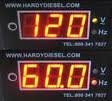Maybe the regulator regulates by sinking the output of the Bridge?
The regulator can't sink the output of the bridge because the connection from the bridge output goes to regulator terminal 18, and that doesn't go to anything that can sink much current.
Or, maybe the VR adds DC to supplement the Bridge output?
The bridge's negative output goes to the regulator's negative bus by way of terminal 12, and its positive output goes to terminal 18, again, not capable of adding to the bridge output.
T1's output passes into the regulator board by terminals 15 and 16, and is then rectified by CR6 and CR7. This DC is sent to Q1 and Q2 in the regulator, which control T3, but it also passes directly out of the regulator by terminal 14 and into current transformer terminal C2. After passing through the three windings, and keeping in mind that this is DC, it then enters the regulator through terminal 17, and is sunk to ground as needed, through T3.
I don't see any conclusion other than the regulator controlling the exciter field by saturating that part of the transformer, which would reduce the input to the bridge. The regulator board's input signals come from the current transformer, and from T1, which is connected to the main output of the generator, so T1 provides the voltage signal to the regulator.
This means that when the output of the generator reaches too high a voltage, the regulator can control that by reducing the output of the bridge that feeds the exciter field, making a proportional feedback loop, Also, when the current requirement of the generator increases, which would cause an output voltage sag, more current is provided by the current sensing transformer to increase exciter field current to prevent the sag before it actually happens, making a sort of derivative feedback loop. The output of the bridge also gets back to the regulator through terminal 18 to R15 (or R16, depending on the version of the regulator), which is capacitively coupled to the base of Q2, so it looks like R15/R16 may control the transient response of the generator output, that is, how well it responds to sudden increases or decreases in load.
My brain hurts, I'm going to get back to work...

Edit: The technical manual has a section for adjusting R15/R16, and says to adjust it counterclockwise until the output voltage becomes unstable, then turn it clockwise until it stabilizes, then continue 2 turns. It goes on to say that instability will be most obvious following the addition or removal of a load. This confirms that R15/16 effects the ability to handle sudden load changes.
Another Edit: From tech manual:
6-3. VOLTAGE REGULATOR.
excitation current is controlled through the static type automatic voltage regulator. The voltage regulator continuously compares the output voltage of the synchronous generator with a stable reference voltage. The difference between the two voltages constitutes an error signal which indicates an output voltage that is higher or lower than the generator set point. This error signal is amplified and used to control the direct current output of the voltage regulator which is applied to the control windings of the current-voltage transformers.
This confirms that the regulator controls the generator by applying current to the current transformer.





